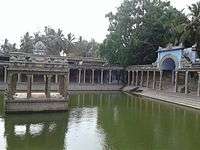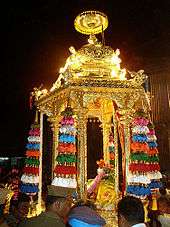Nellaiappar Temple
| Nellaiappar Temple (நெல்லைஅப்பர் திருக்கோவில்) | |
|---|---|
|
| |
| Name | |
| Other names | Venuvanam, Nellur, Saliveli, Salivadi, SaliNagar,Tharugavanam, KeezhaVempu Naattu Kulasekara Sathurvethi Mangalam (as per the ancient stone inscriptions of the temple)[1] |
| Proper name | Nellaiappar Thirukovil |
| Geography | |
| Country | India |
| State | Tamil Nadu |
| Location | Tirunelveli |
| Culture | |
| Primary deity | Nellaiappar (Shiva) |
| Consort | Kanthimathi amman (Parvathi) |
| Architecture | |
| Architectural styles | Tamil architecture |
| History and governance | |
| Date built | 700 AD |
| Creator | Pandyas |
| Website | http://kanthimathinellaiappar.tnhrce.in/ |
Nellaiappar Temple is a Hindu temple dedicated to the deity Shiva, located in Tirunelveli, a city in the South Indian state of Tamil Nadu. Shiva is worshipped as Nellaiappar (also called Venuvananathar) represented by the lingam and his consort Parvati is depicted as Kanthimathi Amman. The temple is located on the Southern banks of Tamiraparani River in Tirunelveli district. The presiding deity is revered in the 7th century Tamil Saiva canonical work, the Tevaram, written by Tamil saint poets known as the nayanmars and classified as Paadal Petra Sthalam.
The temple complex covers an area of six acres and all its shrines are enclosed with concentric rectangular walls. The temple has a number of shrines, with those of Nelliappar, Natarajar and his consort Kanthimathi being the most prominent.
The temple has three six rituals at various times from 6:00 a.m. to 9:00 p.m., and six yearly festivals on its calendar. Brahmotsavam festival during the Tamil month of Thai (January - February) is the most prominent festival celebrated in the temple.
The original complex is believed to have been built by Pandyas, while the present masonry structure was built during the 16th century by Madurai Nayaks. In modern times, the temple is maintained and administered by the Hindu Religious and Charitable Endowments Department of the Government of Tamil Nadu.
History

According to the puranas, both the Gopurams were built by Muluthukanda Rama konar and the other important parts of the temple were constructed by Nindraseer Nedumaran who reigned in the 7th century. The mani mandapam with its famous musical pillar was built by Nindaraseer Nedumaran in the 7th century. Originally the Nellaiappar and Kanthimathi temples were two independent structures with spaces in between. It was in 1647 that Thiru Vadamalaiappa Pillaiyan, a great devotee of Siva linked the two temples by building the "Chain mandapam" (In Tamil Sangili Mandapam). To the western portion of the chain mandapam is the flower garden that was set up in 1756 by Thiruvengadakrishna Mudaliar. In the centre of the Flower Garden is a square vasantha mandapm with 100 pillars. The Nandi mandapam is said to have been built by Sivanthiappa Nayak in 1654. The flag stand near the Nandi was set up in 1155.[2]
There are a number of stone inscriptions in the temple. The most important of them are those Veerapandiyan who regained about 950 and those of Rajendran I and Kulothunga Chola I. The inscriptions of Maravarma Sundara Pandiyan refer to the Lord as "Woodayar" and "Wodeyanayanar" and the Goddess as "Nachiar". From the inscriptions of Kulasekkara Pandiyan we learn that he defeated the Chera, Chola and Hoysala kings and built the outer walls of the temple with the war booty.[3]
Architecture

Nellaiappar temple is spread over 14 acres.The gopuram of this temple is 850 feet long and 756 feet wide.[4] Sangili Mandapam built on 1647 by vadamalaiyappa pillayan connects the Ganthimathi Amman and Nellaiyappar temples.[5]
Thaamira Ambalam
Thirunelveli also is one of the five places where Lord Shiva is said to have displayed his dance and all these places have stages/ ambalams. While Tirunelveli has the Thaamirai (Copper) Ambalam, the others are the Rathina Ambalam at Thiruvaalangadu (rathinam – ruby / red), the Chitra Ambalam at Courtallam (chitra – painting), the Velli Ambalam at Madurai Meenakshi Amman Temple (velli – silver) and the Pon (Gold) Ambalam at Thillai Nataraja Temple, Chidambaram.[6][7]
Religious importance and festivals

Navaratri, Tirukkalyanam in Aippasi, (Oct 15 - Nov 15) and Arudra Darisanam are some of the important festivals here. Arudra Darisanam attracts huge crowds here. The temple chariot is a massive one, second supposedly only to Tiruvarur. The Bhrammotsavam here lasts for an extended period of time during the Tamil month of Aani (June 15 - July 15). Also, a golden temple car (First Inaugural run of Nellaiappar Temple Golden Car is November 2, 2009) will run during important festivals like Thirukalyanam, Kaarthigai, Aaruthra Festival etc. During Thaipoosam festival in Thai, Lord Shiva and Parvathy are taken to the banks of Thamirabarani river in Tirunelveli junction called "Thaipoosa mandapam". Special rituals are undertaken there and the Lord return to the temple at night. Nellaiappar Temple car is the third largest car in Tamil Nadu.And it is the first car to be driven fully automatically.[8]
The temple priests perform the puja (rituals) during festivals and on a daily basis. The temple rituals are performed three times a day; Kalasanthi at 8:00 a.m., Uchikalam at 12:00 a.m. and Sayarakshai at 6:00 p.m. Each ritual comprises four steps: abhisheka (sacred bath), alangaram (decoration), naivethanam (food offering) and deepa aradanai (waving of lamps) for Nelliappar and Kanthimathi Amman. There are weekly rituals like somavaram (Monday) and sukravaram (Friday), fortnightly rituals like pradosham, and monthly festivals like amavasai (new moon day), kiruthigai, pournami (full moon day) and sathurthi. The Thayar Aaratu festival during the Tamil month of Thai (January - February) is the most important festivals of the temple.[9][10]
Pancha Sabhai Sthalangal
The temples where Lord Shiva is believed to have performed the Cosmic Dance.
| Category | Temple | Location | Element |
| Rathinachabai | Vada aaranyeswarar Temple | Thiruvalangadu, Chennai | Emerald |
| Porchabai | Natarajar Temple | Chidambaram | Gold |
| Vellichabai | Meenakshi Amman Temple | Madurai | Silver |
| Thamirachabai | Nellaiappar Temple | Tirunelveli | Copper |
| Chithirachabai | Kutralanathar Temple | Thirukutralam | Art |
Literary mention
Tirugnana Sambandar and Appar, the 7th-century Tamil Saivite poet Nayanmars, venerated Nelliappar in ten verses in Tevaram, compiled as the First Tirumurai. Sundarar, an 8th-century nayanmar, also venerated Idaiyatreeswarar in ten verses in Tevaram, compiled as the Fifth Tirumurai. As the temple is revered in Tevaram, it is classified as Paadal Petra Sthalam, one of the 276 temples that find mention in the Saiva canon.[10] Muthuswami Dikshitar composed one song (Sri Kantimatim) on this temple goddess Kanthimathi Amman.This song is considered to be a rare song set in the rare raga.[4]
References
- ↑ Temple guide published by Tamil Nadu gov; page 2
- ↑ Sthala Varalaru book published in 2004 by temple administration
- ↑ http://www.kanthimathinellaiappar.org
- 1 2 "Muthuswami Dikshithar". Retrieved 28 April 2015.
- ↑ Thirukkoilkal vazhikaatti, Tirunelveli District; tnhrce; August 2014;page 11
- ↑ T. G. S. Balaram Iyer, T. R. Rajagopalan (1987). History & description of Sri Meenakshi Temple. pp.39
- ↑ Rajeshwari Ghose. The Tyāgarāja cult in Tamilnāḍu: A Study in Conflict and Accommodation . pp. 69
- ↑ http://www.kanthimathinellaiappar.tnhrce.in/
- ↑ "Sri Nelliapaar temple". Dinamalar. 2014. Retrieved 24 November 2015.
- 1 2 R., Dr. Vijayalakshmy (2001). An introduction to religion and Philosophy - Tévarám and Tivviyappirapantam (1st ed.). Chennai: International Institute of Tamil Studies. pp. 315–7.
External links
| Wikimedia Commons has media related to Nellaiappar Temple. |
- Nellaiappar Temple official site
- Nellaiappar Temple at Tirunelveli
-
 Nellaiappar Temple travel guide from Wikivoyage
Nellaiappar Temple travel guide from Wikivoyage

